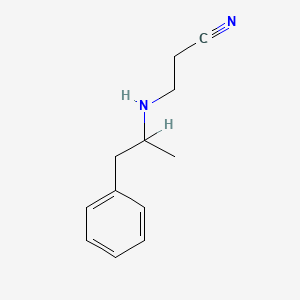

1. Fenproporex Monohydrochloride
2. Fenproporex Monohydrochloride, (+-)-isomer
3. Fenproporex, (+-)-isomer
4. Ifa Diety
1. Desobesi
2. 16397-28-7
3. Femproporex
4. Fenorex
5. 3-(1-phenylpropan-2-ylamino)propanenitrile
6. 3-[(1-methyl-2-phenylethyl)amino]propiononitrile
7. W0194s5foa
8. Fenproporex (inn)
9. J268.797f
10. Fenproporex [inn]
11. Fenproporex [inn:dcf]
12. Femproporex [inn-spanish]
13. Fenproporexum [inn-latin]
14. 3-((1-methyl-2-phenylethyl)amino)propiononitrile
15. Einecs 239-772-0
16. Unii-w0194s5foa
17. Dea No. 1575
18. Einecs 240-444-4
19. Fenorex (tn)
20. Fenproporex [mi]
21. N-2-cyanoethylamphetamine
22. N-(2-cyanoethyl)amphetamine
23. Fenproporex [who-dd]
24. 15686-61-0
25. Schembl157687
26. Chembl2105566
27. Dtxsid0043921
28. Chebi:134837
29. (.+/-.)-n-2-cyanoethylamphetamine
30. Db01550
31. D07947
32. 3-[(1-methyl-2-phenylethyl)amino]propanenitrile #
33. Q5443577
34. (.+/-.)-3-[(.alpha.-methylphenethyl)amino]propionitrile
35. (+/-)-3-((.alpha.-methylphenethyl)amino)propionitrile
36. Propanenitrile, 3-[(1-methyl-2-phenylethyl)amino]-, (.+/-.)-
37. Propionitrile, 3-((.alpha.-methylphenethyl)amino)-, (.+/-.)-
| Molecular Weight | 188.27 g/mol |
|---|---|
| Molecular Formula | C12H16N2 |
| XLogP3 | 1.9 |
| Hydrogen Bond Donor Count | 1 |
| Hydrogen Bond Acceptor Count | 2 |
| Rotatable Bond Count | 5 |
| Exact Mass | 188.131348519 g/mol |
| Monoisotopic Mass | 188.131348519 g/mol |
| Topological Polar Surface Area | 35.8 Ų |
| Heavy Atom Count | 14 |
| Formal Charge | 0 |
| Complexity | 186 |
| Isotope Atom Count | 0 |
| Defined Atom Stereocenter Count | 0 |
| Undefined Atom Stereocenter Count | 1 |
| Defined Bond Stereocenter Count | 0 |
| Undefined Bond Stereocenter Count | 0 |
| Covalently Bonded Unit Count | 1 |
Fenproporex is used as an appetite suppressant, and anti-obesity agent [2]; however, due to substance abuse potential, it is an illicit substance in many countries. In some countries, such as Brazil, it is still prescribed -- often in the form of diet pills (ie. Brazilian Diet Pills) which combine amphetamines, benzodiazepines, antidepressants, diuretics and laxatives. In the United States the sale of such diet pills has been banned due to concerns over side effects, and the risk of potentially fatal overdose. However, internet sales and illicit markets has lead to international availability. It has been found by primary care physicians that Brazilian immigrant women utilized imported diet pills at particularly high rates, and sometimes suffered from side effects requiring hospitalization or experienced a loss of employment. [3]
Fenproporex was first claimed to not exert a stimulant effect on the body, however research into its metabolism has shown that it is converted into a considerable amount of amphetamine in the body, which leads to stimulant effects. [9]
Route of Elimination
Renally eliminated in the urine, mainly as amphetamine, but 5-9% as unchanged drug.
Clearance
The amphetamine metabolite can be detected for several days after the administration of forproporex (up to 119h, in one study). [2]
A large portion, 60-80%, of fenproporex is rapidly converted into amphetamine. Besides amphetamine, and unchanged fenproporex, 14 other metabolites were identified from urine samples. Two interacting metabolic pathways are believed to exist. The major pathway is believed to involve ring-degradation by aromatic hydroxylation, methylation, and side chain degradation by N-dealkyation to form amphetamine. The minor pathway involves the beta-hydroxylation of amphetamine to form norephedrine. [6]
Fenproporex is an amphetamine based anorectic which is rapidly metabolized into amphetamine in the body. Both acute and chronic fenproporex administration has been shown to increase brain energy metabolism in young rats, by increasing the activity of citrate synthase, malate dehydrogenase, succinate dehydrogenase, creatine kinase and complexes I,II, III, and IV. [8] Amphetamine based drugs are also known to reduce food intake. They are addictive substances due to their ability to increase dopamine release, however their anorectic effects are believed to be a result of noradrenergic neurotransmission. Activation of the alpha 1 and beta 2 adrenoceptors has been shown to decrease food intake, and drugs which release norepinephrine or block norepinephrine reuptake can activate these receptors. [3] The alpha 1 and beta 2 adrenoceptors are noted to be clinically important receptors in weight regulation. [3]
